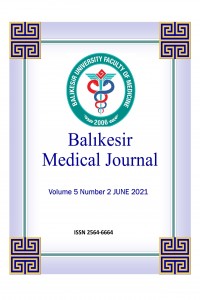Subkorakoid sıkışmada, korakoid morfolojisinin, korakohumeral mesafenin, korakoglenoid açının ve korakohumeral açının MRG ile değerlendirilmesi
Öz
Anahtar Kelimeler
Manyetik Rezonans Görüntüleme Subskapular tendon Subkorakoid sıkışma Korakois proses
Kaynakça
- Brunkhorst JP, Giphart JE, LaPrade RF, Millett PJ: Coracohumeral distances and correlation to arm rotation: An in vivo 3-dimensional biplane fluoroscopy study. Orthop J Sports Med, 2013; 1: 2325967113496059.
- Friedman RJ, Bonutti PM, Genez B: Cine magnetic resonance imaging of the subcoracoid region. Orthopedics. 1998; 21:545–8.
- Okoro T, Reddy VR, Pimpelnarkar A: Coracoid impingement syndrome: A literature review. Curr Rev Musculoskelet Med, 2009; 2:51–5.
- Dugarte AJ, Davis RJ, Lynch TS , Schickendantz MS, Farrow LD. Anatomic study of subcoracoid morphology in 418 shoulders: Potential implications for subcoracoid impingement. Orthop J Sports Med, 2017; 5: 2325967117731996
- Watson AC, Jamieson RP, Mattin AC, Page RS: Magnetic resonance imaging based coracoid morphology and its associations with subscapularis tears: A new index. Shoulder & Elbow, 2017; 1758573217744170
- Asal N, Şahan MH. Radiological Variabilities in Subcoracoid Impingement: Coracoid Morphology, Coracohumeral Distance, Coracoglenoid Angle, and Coracohumeral Angle. Med Sci Monit, 2018; 24: 8678-84.
- Gerber C, Terrier F, Ganz R: The role of the coracoid process in the chronic impingement syndrome. J Bone Joint Surg Br, 1985; 67: 703–8.
- Freehill MQ: Coracoid impingement: Diagnosis and treatment. J Am Acad Orthop Surg, 2011; 19: 191–97.
- Giaroli EL, Major NM, Lemley DE, Lee J. Coracohumeral interval imaging in subcoracoid impingement syndrome on MRI. Am J Roentgenol, 2006; 186: 242–46.
- Richards DP, Burkhart SS, Campbell SE: Relationship between narrowed coracohumeral distance and subscapularis tears. Arthroscopy, 2005; 21: 1223–28.
- Hekimoglu B, Aydın H, Kızılgöz V, Tatar IG, Ersan O. Quantitative measurement of humero-acromial, humero-coracoid, and coracoclavicular intervals for the diagnosis of subacromial and subcoracoid impingement of shoulder joint. Clin Imaging, 2013; 37:201–10.
- Nair AV, Rao SN, Kumaran CK, Kochukunju BV: Clinico-radiological correlation of subcoracoid impingement with reduced coracohumeral interval and its relation to subscapularis tears in Indian patients. J Clin Diagn Res, 2016; 10: RC17–20.
MRI evaluation of coracoid morphology, coracohumeral distance, coracoglenoid angle and coracohumeral angle in subcoracoid impingement
Öz
Anahtar Kelimeler
magnetic resonance imaging subscapular tendon subcoracoid impingement coracoid process
Kaynakça
- Brunkhorst JP, Giphart JE, LaPrade RF, Millett PJ: Coracohumeral distances and correlation to arm rotation: An in vivo 3-dimensional biplane fluoroscopy study. Orthop J Sports Med, 2013; 1: 2325967113496059.
- Friedman RJ, Bonutti PM, Genez B: Cine magnetic resonance imaging of the subcoracoid region. Orthopedics. 1998; 21:545–8.
- Okoro T, Reddy VR, Pimpelnarkar A: Coracoid impingement syndrome: A literature review. Curr Rev Musculoskelet Med, 2009; 2:51–5.
- Dugarte AJ, Davis RJ, Lynch TS , Schickendantz MS, Farrow LD. Anatomic study of subcoracoid morphology in 418 shoulders: Potential implications for subcoracoid impingement. Orthop J Sports Med, 2017; 5: 2325967117731996
- Watson AC, Jamieson RP, Mattin AC, Page RS: Magnetic resonance imaging based coracoid morphology and its associations with subscapularis tears: A new index. Shoulder & Elbow, 2017; 1758573217744170
- Asal N, Şahan MH. Radiological Variabilities in Subcoracoid Impingement: Coracoid Morphology, Coracohumeral Distance, Coracoglenoid Angle, and Coracohumeral Angle. Med Sci Monit, 2018; 24: 8678-84.
- Gerber C, Terrier F, Ganz R: The role of the coracoid process in the chronic impingement syndrome. J Bone Joint Surg Br, 1985; 67: 703–8.
- Freehill MQ: Coracoid impingement: Diagnosis and treatment. J Am Acad Orthop Surg, 2011; 19: 191–97.
- Giaroli EL, Major NM, Lemley DE, Lee J. Coracohumeral interval imaging in subcoracoid impingement syndrome on MRI. Am J Roentgenol, 2006; 186: 242–46.
- Richards DP, Burkhart SS, Campbell SE: Relationship between narrowed coracohumeral distance and subscapularis tears. Arthroscopy, 2005; 21: 1223–28.
- Hekimoglu B, Aydın H, Kızılgöz V, Tatar IG, Ersan O. Quantitative measurement of humero-acromial, humero-coracoid, and coracoclavicular intervals for the diagnosis of subacromial and subcoracoid impingement of shoulder joint. Clin Imaging, 2013; 37:201–10.
- Nair AV, Rao SN, Kumaran CK, Kochukunju BV: Clinico-radiological correlation of subcoracoid impingement with reduced coracohumeral interval and its relation to subscapularis tears in Indian patients. J Clin Diagn Res, 2016; 10: RC17–20.
Ayrıntılar
| Birincil Dil | Türkçe |
|---|---|
| Konular | Klinik Tıp Bilimleri |
| Bölüm | ARAŞTIRMA MAKALESİ |
| Yazarlar | |
| Yayımlanma Tarihi | 25 Haziran 2021 |
| Yayımlandığı Sayı | Yıl 2021 Cilt: 5 Sayı: 2 |

Bu eser Creative Commons Alıntı-GayriTicari-Türetilemez 4.0 Uluslararası Lisansı ile lisanslanmıştır.


